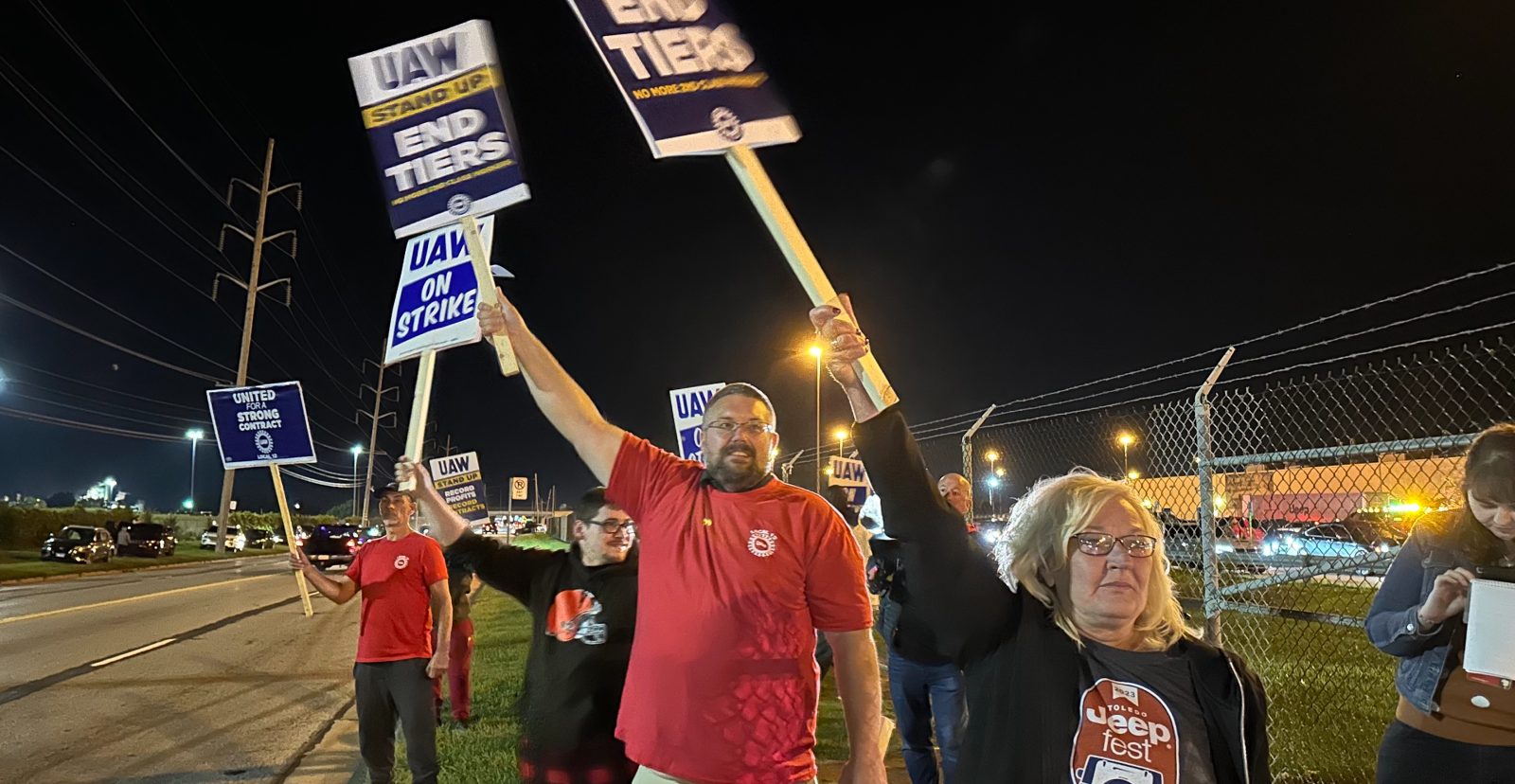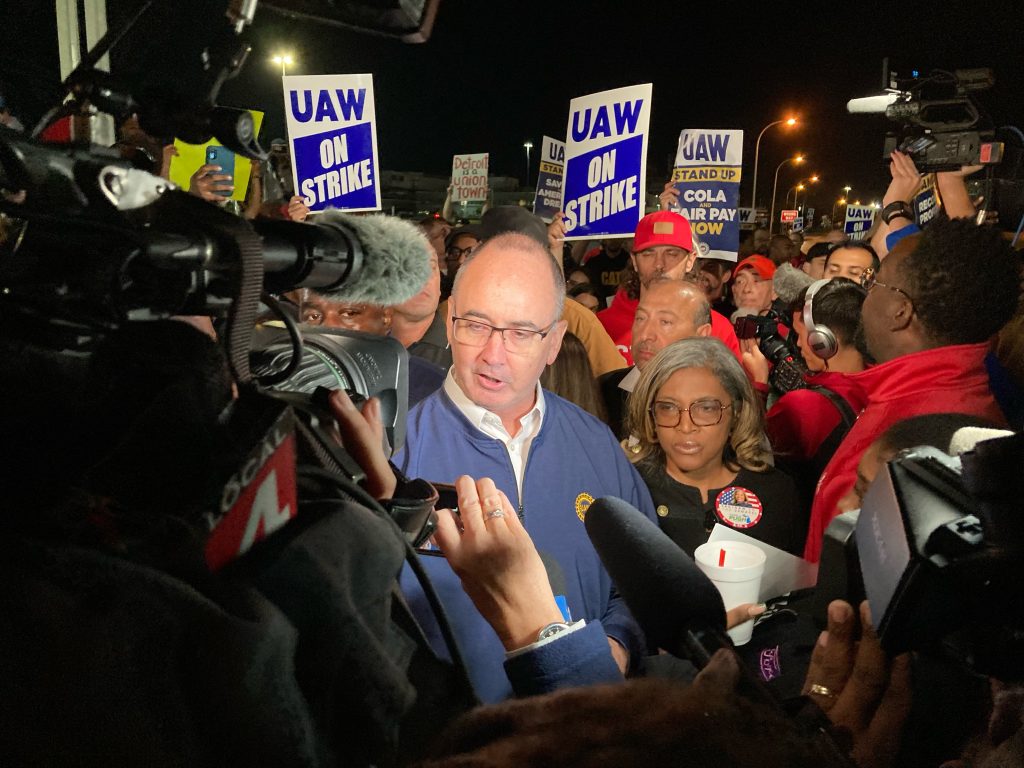
The United Auto Workers union has begun a strike against all three major American automakers, with about 12,700 workers currently on strike, and the potential for up to 146,000 total to go on strike in the future if automakers do not offer the union a satisfactory agreement.
While this strike is not specifically EV-focused, this story is nevertheless related to our coverage since it affects the auto industry as a whole, and many EVs are built by union labor by the “Big Three” US automakers (GM, Ford, and Chrysler, which is now a part of Stellantis).
However, currently the strike doesn’t include all unionized US auto workers. Of the ~146,000 UAW workers in the US, only 12,700 of them have walked off the job for the time being, at one plant for each of the three automakers.
The plants targeted for shutdown are GM’s Wentzville Assembly in Missouri, Ford’s Michigan Assembly in Wayne, MI, and Stellantis’ Toledo Assembly Complex in Ohio.
Of those three plants, the only one that currently produces an electrified vehicle is the Stellantis plant in Ohio, which builds Jeep Wranglers. This includes the Wrangler 4xe, a plug-in hybrid Jeep with a 17.3kWh battery pack and 21 miles of all-electric range.
There are no pure BEVs built at the three plants in question, so EVs have mostly escaped for the time being. In fact, with fewer gas vehicles being built, this could even benefit EVs in the short term – but that could change at any moment.
New leadership, new tactics
As of this year, the union is under new leadership. In March, it held the first direct election in its 88-year history, electing its current president Shawn Fain after previous appointed presidents were subject to scandal.

Fain has called this new tactic of closing a few plants at a time a “stand-up strike.” This allows the union to show that it is serious about striking, but to gradually increase pressure on the Big Three with the threat of expanding the strike to more plants if automakers do not offer enough to the union. It also means that strike funds will last longer – the UAW current has around $825 million in strike funds earmarked to pay workers while they’re off the line.
This new “stand up” nomenclature is meant to contrast with the “sit-down strikes” of the past, where workers would arrive to work at their stations and then simply sit down in place – thus preventing the potential for companies to hire scabs to replace striking workers.
Previously, the UAW would normally strike against a single automaker at a time, typically with one or a few plants. This is the first time it has held a strike against all three automakers at once, though it is still only walking out of some facilities for the time being. But that could change, and the strike could expand to cover more vehicles – and potentially some BEVs – if automakers don’t improve their offers.
In the run-up to this strike, automakers have already offered significant pay increases, but these fall short of what the union considers acceptable. At first, automakers were offering around a ~10% increase, and more recent proposals have risen to around ~20%, though there are other provisions that are being negotiated for as well.
But the union says that these numbers are not high enough. Fain points to profits and executive pay, which he says have gone up 65% and 40% over the last four years, in comparison to autoworker pay, which has risen only 6%.
The Big Three counter this by stating that if their labor costs increase, this could put them at a disadvantage against non-unionized automakers like Tesla, Toyota, and other foreign automakers in the US. Many of these automakers are building factories in the US already.
And with the economy in somewhat of a rocky place recently, a swift end to this strike is in the interest of many. It is estimated that just a 10-day strike could cost the US economy $5 billion, so negotiations will surely be frantic.
Unions have been having a bit of a moment this year, with many strikes happening around the country. Public approval of unions is around its highest point since 1965, which has given labor the momentum to push for better protections as several industries are in times of disruption. Americans tend to favor striking auto workers and film & TV workers over their employers at a margin of three or four to one.
Electric cars and unions
In the auto industry specifically, electric cars have been in focus because electric cars typically have fewer parts than gas-powered vehicles, and thus require fewer human assembly hours. This is a benefit as the cars are less complex, but it also means that fewer auto workers may be needed to build the same number of cars.
Also, as automakers are building battery plants in the US, some are trying to start battery assembly jobs at lower hourly rates than traditional auto assembly jobs have paid. GM’s Ultium battery workers, who unionized earlier this year, just earned a 25% pay raise last month, noting this discrepancy in starting pay.
This was the first big union win in US EV production, as US battery production has heretofore mostly been non-unionized. In particular, the largest US EV maker, Tesla, has seen some unionization efforts, but those efforts have mostly met with retaliation from Tesla CEO Elon Musk.

Unions have at times been somewhat skeptical of the transition to electric vehicles, largely due to this reduction in total hours of labor needed for assembly. Though this doesn’t apply to all unions – in Germany, Audi’s worker union demanded that EVs be built at the main plant, thinking that if they did not embrace the EV transition, they might lose their jobs entirely anyway as the industry moves toward EV.
Labor was also central to President Biden’s original Build Back Better proposal, which would have added an additional $4,500 tax credit for union-made EVs, but that provision didn’t make it to the final bill due to opposition from all Senate Republicans and Joe Manchin. That proposal ended up going into law as the Inflation Reduction Act, which gives a $7,500 tax credit to EVs that are built in the US, though without a union requirement attached.
Electrek’s Take
Personally, I’m pro-union. And I think that everyone should be – it only makes sense that people should have their interests collectively represented, and that people should be able to join together to support each other and exercise their power collectively, instead of individually.
This is precisely what companies do with industry organizations, lobby organizations, chambers of commerce, and so on. And it’s what people do when sorting themselves into local, state, or national governments. So naturally, workers should do the same. It only makes sense.
Top comment by GoldQuill
Tesla and Toyota workers should unionize.
If you’ve ever had a job with workplace safety rules, or a 5-day workweek, or a 35-40-hr workweek, or health benefits, or vacation time, or parental leave, or a retirement program, or sick days, thank the unions. Had there never been unions, you wouldn’t have those benefits.
But at times, unions can have conservative views on manufacturing. In particular, they are interested in maintaining jobs for all of their members, which makes sense from their perspective.
But if the climate crisis requires that we produce fewer and/or smaller personal vehicles, as it does, and if those vehicles must be electric, as they must, then this means we simply have to have fewer auto manufacturing jobs in the future. It’s just going to happen. There is simply no way to get around it while also working to reduce emissions.
This could put unions in a tough spot, because they want to protect their workers, but hopefully still recognize the necessity of a rapid transition to cleaner transportation options.
There’s no reason we can’t have both things, and currently the unions don’t seem to be working against the transition at all, nor do I expect them to. I hope we can continue on this same path, and unions and the auto industry can both embrace electrification in the most rapid way possible (that is, even more rapidly than anyone currently is), while still maintaining worker protections and high levels of manufacturing quality.
FTC: We use income earning auto affiliate links. More.



Comments